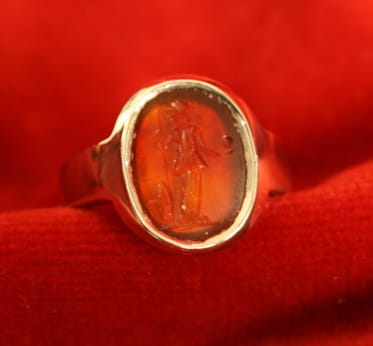Roman Carnelian Intaglio Depicting Minerva, 100 CE - 300 CE
Carnelian, Gold
FJ.6832
This Genuine Ancient Seal Has Been Set in a Modern 18 Karat White Gold Rin The art of glyptics, or carving on colored precious stones, is probably one of the...
This Genuine Ancient Seal Has Been Set in a Modern 18 Karat White Gold Rin
The art of glyptics, or carving on colored precious stones, is probably one of the oldest known to humanity. Intaglios, gems with an incised design, were made as early as the fourth and third millennia B.C. in Mesopotamia and the Aegean Islands. They exhibit a virtuosity of execution that suggests an old and stable tradition rooted in the earliest centuries. The tools required for carving gems were simple: a wheel with a belt-drive and a set of drills. Abrasives were necessary since the minerals used were too hard for a metal edge. A special difficulty of engraving intaglios, aside from their miniature size, was that the master had to work with a mirror-image in mind.
Engraved onto the polished surface of this precious gemstone is an image of Minerva, the famed Goddess of Wisdom and War who is identified with the Greek Athena. Daughter of Jupiter, Minerva is depicted with her standard attributes: a lance, shield, and a crested helmet. These attributes all convey her role as the goddess of War. However, Minerva was not a violent, aggressive deity. Quite to the contrary, she was the embodiment of divine wisdom. How can war and wisdom coexist together in the same deity? Perhaps because there are those occasions when even the wisest ruler recognizes that conflict is inevitable. Thus Minerva does not represent a conquering force, but a prudent wisdom that recognizes the possibility of battle and is prepared for it. In Minerva we see the two extremes of humanity: education and war. Although these two extremes seem at odds, civilization exists somewhere between them as embodied by Minerva.
The art of glyptics, or carving on colored precious stones, is probably one of the oldest known to humanity. Intaglios, gems with an incised design, were made as early as the fourth and third millennia B.C. in Mesopotamia and the Aegean Islands. They exhibit a virtuosity of execution that suggests an old and stable tradition rooted in the earliest centuries. The tools required for carving gems were simple: a wheel with a belt-drive and a set of drills. Abrasives were necessary since the minerals used were too hard for a metal edge. A special difficulty of engraving intaglios, aside from their miniature size, was that the master had to work with a mirror-image in mind.
Engraved onto the polished surface of this precious gemstone is an image of Minerva, the famed Goddess of Wisdom and War who is identified with the Greek Athena. Daughter of Jupiter, Minerva is depicted with her standard attributes: a lance, shield, and a crested helmet. These attributes all convey her role as the goddess of War. However, Minerva was not a violent, aggressive deity. Quite to the contrary, she was the embodiment of divine wisdom. How can war and wisdom coexist together in the same deity? Perhaps because there are those occasions when even the wisest ruler recognizes that conflict is inevitable. Thus Minerva does not represent a conquering force, but a prudent wisdom that recognizes the possibility of battle and is prepared for it. In Minerva we see the two extremes of humanity: education and war. Although these two extremes seem at odds, civilization exists somewhere between them as embodied by Minerva.
